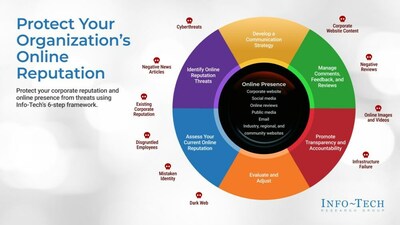Info-Tech Research Group Unveils Strategies to Safeguard Organizations' Online Reputation in a Dynamic Digital Landscape
- Assess the Current Online Reputation: The first step in protecting an organization's online reputation is to identify its current state. It's important to know how the brand is currently perceived and where to focus attention for improvements.
- Identify Online Reputation Threats: Discovering potential threats and risks to an organization's online reputation is crucial. This involves identifying both internal and external risks, such as ethical concerns, product recalls, negative reviews, and competitor actions, and evaluating their potential impact. This step is fundamental in preemptively managing and mitigating threats to maintain a positive brand image.
- Develop a Communication Strategy: It's essential to develop a communication strategy that includes messaging that promotes the organization's values, mission, and ethical practices, as well as a crisis communication plan that outlines how the company will respond in the event of a negative incident.
- Manage Comments, Feedback, and Reviews: Managing customer feedback and online reviews is critical to protecting brand reputation. It allows organizations to acknowledge positive feedback and address negative feedback, showing customers that they are responsible and transparent.
- Promote Transparency and Accountability: Organizations can build trust with employees, customers, and other stakeholders by being transparent about operations and decision-making processes. This process includes being open about social, ethical, or other challenges and how the company addresses them.
- Evaluate and Adjust: To ensure brand reputation protection strategies remain effective, they must be regularly evaluated and adjusted. This includes monitoring metrics such as online sentiment, customer satisfaction, and brand loyalty and adjusting communication strategies and tactics as needed.
SOURCE Info-Tech Research Group





Comments
Post a Comment